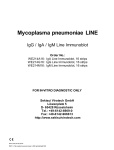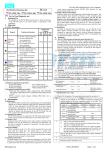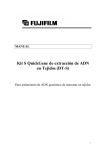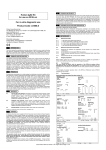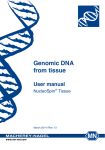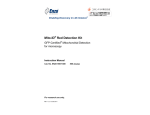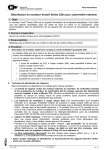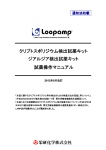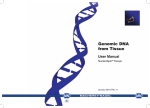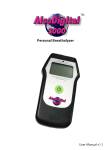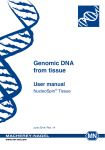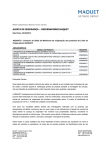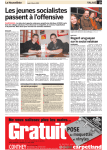Download ISOLATE II Genomic DNA Kit
Transcript
ISOLATE II Genomic DNA Kit Product Manual Genomic DNA Kit ISOLATE II Genomic DNA Kit ISOLATE II Genomic DNA Kit 1 Kit contents 04 2 Description 04 3 Storage 05 4 Safety information 05 5 Product specification 05 6 Equipment and reagents to be supplied by the user 07 7 Important notes 07 7.1 07 8 Standard protocol 8.1 9 10 Buffer preparation and parameters Purifying total DNA from cultured cells and human or animal tissue 08 08 Alternative protocols 09 9.1 Mouse or rat tails 09 9.2 Bacteria 10 9.3 Yeast 11 9.4 Dried blood spots 11 9.5 Genomic/viral DNA from blood 12 9.6 Hair roots 12 9.7 Paraffin-embedded tissue 13 9.8 Genomic DNA from fecal material 13 9.9 Viral DNA from fecal material 14 9.10 Bacterial DNA from urine 16 9.11 Viral DNA from urine 16 9.12 Bacterial DNA from cultures, clinical specimens or biological fluids 17 9.13 Detection of Mycobacterium tuberculosis or Legionella pneumophila in respiratory samples 18 9.14 Detection of Enterohemorrhagic E. coli in food 19 9.15 Genomic DNA from dental swabs 19 9.16 Genomic DNA from buccal swabs 20 9.17 Genomic DNA from insects 21 9.18 Genomic DNA from semen 22 Troubleshooting guide 24 General Information 2 Product Manual www.bioline.com/isolate A. Technical support 26 B. Ordering information 26 C. Associated products 26 D. Product warranty and disclaimer 26 3 Genomic DNA Kit 3. STORAGE 1. KIT CONTENTS COMPONENT ISOLATE II Genomic DNA Spin Columns (green) 10 Preps 50 Preps 250 Preps 10 50 250 Collection Tubes (2ml) 20 100 500 Lysis Buffer GL 5ml 20ml 100ml Buffer G1 6ml 12ml 60ml Buffer G2 1.5ml 3ml 15ml Wash Buffer GW1 6ml 30ml 2 x 75ml Wash Buffer GW2† (concentrate) 4ml 2 x 7ml 2 x 40ml Elution Buffer G 3ml 15ml 75ml Proteinase K (lyophilized) 6mg 30mg 2 x 75mg Proteinase K Buffer PR 0.8ml 1.8ml 8ml Labels for Lysis Buffer G3 1 1 1 User Manual 1 1 1 Bench Protocol Sheet 1 1 1 † Before use, add indicated volume of 96-100% ethanol and mark wash buffer bottle label. Dissolved Proteinase K solution is stable at-20°C for up to 6 months. All other kit components should be stored at room temperature (18–25°C) and are stable for up to 1 year. Storage at lower temperatures may cause precipitation of salts in Buffers GL, G1 or G3. Incubate bottle at 50-70°C prior to use to dissolve precipitates. 4. SAFETY INFORMATION When working with chemicals, always wear a suitable lab coat, gloves and safety glasses. Buffer G1 and Wash Buffer GW1 contain guanidine hydrochloride. This chemical is harmful when in skin contact, inhaled or ingested. For detailed information, please consult the material data safety sheets (MSDSs) available on our website at www.bioline.com. 5. PRODUCT SPECIFICATIONS The ISOLATE II Genomic DNA Kit is specially designed for the rapid and efficient isolation of extremely pure genomic DNA from any tissue, cells, bacteria, yeast, forensic samples, serum, plasma, or other body fluids. The hands on time is 20 min for 4-6 preps following the lysis steps. The isolated DNA is of high purity (A 260/A 280 ratio: 1.7-1.9) with yields of 20-35μg (see below). 2. DESCRIPTION The ISOLATE II Genomic DNA Kit is a simple, reliable and fast method for isolation of highquality genomic DNA from a variety of sample sources. Biological samples are first lysed in chaotropic salt ions in the presence of Proteinase K. Ethanol is added to the sample and then processed through a genomic DNA mini spin column containing a silica membrane to which the genomic DNA binds. Contaminants and impurities such as salts, metabolites and cellular components are effectively removed by simple washing steps with two different buffers. High-quality purified genomic DNA is then eluted in an elution buffer. ISOLATE II GENOMIC DNA COLUMN SPECIFICATIONS Max. binding capacity A 260/A 280 60μg DNA 1.7-1.9 Typical yield 20–35μg Elution volume 60-100μl Sample material Tissue 1–25mg Cells 102–107 Please read this manual carefully to familiarize yourself with the ISOLATE II Genomic DNA protocol before starting (also available on www.bioline.com). More experienced users can refer to the bench-top protocol for quick referencing during the procedure. 4 Product Manual www.bioline.com/isolate 5 Genomic DNA Kit 6. EQUIPMENT AND REAGENTS TO BE SUPPLIED BY USER Genomic DNA Isolation Sample preparation Place up to 25mg tissue into 1.5ml tube When working with chemicals, always wear a suitable lab coat, protective goggles and disposable gloves. Bind DNA Load lysate 11,000 x g, 1 min Sample pre-lysis Add 180µl Lysis Buffer GL + 25µl Proteinase K solution Wash silica membrane 1st wash 500µl Wash Buffer GW1 2nd wash 600µl Wash Buffer GW2 • 96-100% ethanol† (for Wash Buffer GW2) • Microcentrifuge tubes (1.5ml) • Sterile DNase-free tips •Pipettes • Microcentrifuge (capable of 11,000 x g) • Vortex mixer • Thermal heating block • Equipment for sample disruption and homogenization • Personal protection equipment (lab coat, gloves, goggles) Molecular biology grade ethanol is recommended. Do not use denatured alcohol which contains unwanted additives such as methanol and acetone. † Vortex 1st and 2nd 11,000 x g, 1 min Incubate 56oC, 1-3 hrs or overnight Dry silica membrane 11,000 x g, 1 min Vortex Sample lysis Add 200µl Lysis Buffer G3 and vortex Incubate 70oC, 10 min Elute DNA Add 100µl Elution Buffer G (70oC) Incubate RT, 1 min 11,000 x g, 1 min Adjust DNA binding conditions Add 210µl ethanol Vortex Isolated DNA 7. IMPORTANT NOTES 7.1 BUFFER PREPARATION AND PARAMETERS Preparing Lysis Buffer G3 Transfer the contents of Buffer G1 to Buffer G2. Mix well and label Lysis Buffer G3 on the bottle. Note: The resulting Lysis Buffer G3 is stable for up to one year at room temperature. If a white precipitate forms in Lysis Buffer G3 at any time, re-dissolve by incubating the bottle at 70°C before use. Preparing Wash Buffer GW2 Add 96–100% ethanol to Wash Buffer GW2 Concentrate: 16ml for the 10 prep kit, 28ml for the 50 prep kit and 160ml x 2 for the 250 prep kit. Note: Mark bottle label to indicate ethanol was added. Store Wash Buffer GW2 at room temperature for up to 1 year. Preparing Proteinase K Buffer PR Add Proteinase K Buffer PR to the lyophilized Proteinase K: 260μl for the 10 prep kit, 1.35ml for the 50 prep kit and 3.35ml x 2 for the 250 prep kit. Note: Proteinase K solution is stable at-20°C for up to 6 months. Elution parameters It is possible to modify the elution protocol to improve yield and concentration. Use Elution Buffer G preheated to 70°C for one of the following procedures: • High yield: Two elution steps with 100μl Elution Buffer G (to increase yield to 90–100%). • High concentration: One elution step with 60μl Elution Buffer G (to increase concentration by about 130%). Maximal yield 80%. 6 Product Manual www.bioline.com/isolate 7 Genomic DNA Kit • High yield and high concentration: Two elution steps. Add 50μl Elution Buffer G, incubate for 3 min and centrifuge, repeat with a second 50μl Elution Buffer G. Yield 85–100% at a high concentration. DNA Storage Store isolated DNA at-20°C. Several freeze-thaw cycles will not interfere with most downstream applications, however for long-range PCR or high sensitivity (especially in realtime PCR), store in aliquots to avoid multiple freeze-thawing. 3 Note: If insoluble particles are visible, centrifuge for 5 min at high speed and transfer the supernatant to a new microcentrifuge tube. 4 Adjust DNA binding conditions Vortex briefly and add 210µl ethanol (96-100%) to the sample. Vortex vigorously. Note: After addition of ethanol a stringy precipitate may become visible. This will not affect the DNA isolation. 5 Bind DNA For each sample, place an ISOLATE II Genomic DNA Spin Column into a Collection Tube. Add all of the sample to the column and centrifuge for 1 min at 11,000 x g. Discard the flow-through and reuse Collection Tube. Repeat at a higher g force if samples are not completely filtered through matrix. 6 Wash silica membrane • Add 500µl Wash Buffer GW1. Centrifuge for 1 min at 11,000 x g. Discard flowthrough and reuse Collection Tube. • Add 600µl Wash Buffer GW2 to the column and centrifuge for 1 min at 11,000 x g. Discard flow-through and reuse Collection Tube. 8. STANDARD PROTOCOL 8.1 PURIFYING DNA FROM CULTURED CELLS AND HUMAN OR ANIMAL TISSUE Before you start: • Make sure Lysis Buffer G3, Wash Buffer GW2 and Proteinase K are prepared (see section 7.1). • Set an incubator or water bath to 56°C. • Preheat Elution Buffer G to 70°C. Lyse sample Vortex sample briefly and add 200µl Lysis Buffer G3. Vortex vigorously and incubate at 70°C for 10 min. 1 Sample preparation 1.1 Human or animal tissue Cut 25mg of tissue into small pieces. Place the sample in a 1.5ml microcentrifuge tube (proceed to step 2). 7 Dry silica membrane Centrifuge 1 min at 11,000 x g, to remove residual ethanol. Place the ISOLATE II Genomic DNA Spin Column in a 1.5ml microcentrifuge tube (not supplied). Note: Samples that are difficult to lyse can be ground under liquid nitrogen or may be treated in a mechanical homogenizer: Add 25mg of tissue to a 1.5ml microcentrifuge tube (not supplied), add 50–75µl PBS and homogenize. 8 Elute DNA Add 100μl preheated Elution Buffer G (70°C) directly onto the silica membrane. Incubate at room temperature for 1 min. Centrifuge 1 min at 11,000 x g. 1.2 2 Cultured cells Resuspend up to 107 cells in a final volume of 200µl Lysis Buffer GL. Add 25µl Proteinase K solution and 200µl Lysis Buffer G3. Incubate the sample at 70°C for 1015 min (proceed to step 4). Pre-lysis Add 180µl Lysis Buffer GL and 25µl Proteinase K solution, completely cover sample with solution and vortex. Note: If processing several samples, Proteinase K and Lysis Buffer GL may be premixed directly before use (no more than 10–15 min before addition to the sample, as Proteinase K will self-digest in Lysis Buffer GL without substrate). Incubate at 56°C for 1–3 hours (until completely lysed), shake or vortex occasionally. Note: Samples can be incubated overnight. If RNA-free DNA is needed for downstream applications, an RNase digest may be performed (RNase not included). Note: For alternative elution procedures see section 7.1. 9. ALTERNATIVE PROTOCOLS 9.1 MOUSE OR RAT TAILS Before you start: • Make sure Lysis Buffer G3, Wash Buffer GW2 and Proteinase K are prepared (see section 7.1). • Set an incubator or water bath to 56°C. • Preheat Elution Buffer G to 70°C. 1 Sample preparation Cut two 0.6cm pieces of mouse tail and place in a 1.5ml centrifuge tube (not supplied). Note: For rat tails, one 0.6cm piece is sufficient. 8 Product Manual www.bioline.com/isolate 9 Genomic DNA Kit 2 Pre-lysis Add 180µl Lysis Buffer GL and 25µl Proteinase K solution. Completely cover sample with solution and vortex. 9.3 YEAST Before you start: • Make sure Lysis Buffer G3, Wash Buffer GW2 and Proteinase K are prepared (see Note: If processing several samples, Proteinase K and Lysis Buffer GL may be premixed directly before use (no more than 10–15 min before addition to the sample, as Proteinase K will self-digest in Lysis Buffer GL without substrate). • Incubate at 56°C overnight (or until completely lysed), shaking or vortexing occasionally. To remove residual bone, hair etc., centrifuge for 5 min at 11,000 x g. Transfer 200µl supernatant to a new centrifuge tube. • • • 3 Lyse sample Vortex sample briefly and add 200µl Lysis Buffer G3. Vortex vigorously. 4 Adjust DNA binding conditions Add 210µl ethanol (96–100%) to the sample. Vortex vigorously. Proceed with step 5 of the standard protocol (see section 8.1). 1 Sample preparation Centrifuge 3ml YPD yeast culture (OD600 ≤10) for 10 min at 5,000 x g. Remove supernatant. Wash once with 1ml 10mM EDTA, pH 8 and centrifuge for 10 min at 5,000 x g. 2 Pre-lysis Resuspend the pellet in 600µl sorbitol buffer and add 50U lyticase or zymolase. Incubate at 30°C for 30 min. This step degrades the yeast cell wall creating spheroplasts. Spheroplast formation may be checked microscopically. 9.2 BACTERIA Before you start: • Make sure Lysis Buffer G3, Wash Buffer GW2 and Proteinase K are prepared (see section 7.1). • For hard-to-lyse bacteria make up the following lysis buffer (20mM Tris/HCl; 2mM EDTA; 1% Triton X-100; pH 8, supplemented with 20mg/ml lysozyme or 0.2mg/ml lysostaphin) (not supplied). • Set an incubator or water bath to 56°C. • Preheat Elution Buffer G to 70°C. 1 2 Sample preparation Up to 1ml of bacterial culture can be used for the preparation depending on density, culture medium, bacterial strain etc. Centrifuge up to 1ml culture for 5 min at 8,000 x g. Remove supernatant. Pre-lysis Resuspend pellet in 180µl Lysis Buffer GL and 25µl Proteinase K solution and vortex vigorously. Incubate at 56°C for 1–3 hours (until completely lysed), shake or vortex occasionally. Note: Samples can be incubated overnight. If RNA-free DNA is needed for downstream applications, an RNase digest may be performed (RNase not included). Note: For hard-to-lyse bacteria such as Gram-positive bacteria, a preincubation is necessary: Resuspend the pelleted cells in a lysis buffer (instead of Lysis Buffer GL, see above) supplemented with lysozyme or lysostaphin and incubate for 30-60 min at 37°C. Add 25µl Proteinase K, incubate at 56°C until complete lysis is obtained. section 7.1). Make up sorbitol buffer (1.2M sorbitol; 10mM CaCl2; 0.1M Tris/HCl pH 7.5; 35mM ß-mercaptoethanol) (not supplied). Check that lyticase or zymolyase (not supplied) is available. Set an incubator or water bath to 30°C and 56°C. Preheat Elution Buffer G to 70°C. Note: Concentration of lyticase or zymolyase can be increased up to 200U if spheroplasts are not found. Centrifuge for 10 min at 2,000 x g and resuspend the pelleted spheroplasts in 180µl Lysis Buffer GL and 25µl Proteinase K solution and vortex vigorously. Incubate at 56°C for 1–3 hours (until completely lysed), shaking or vortexing occasionally. Note: Samples can be incubated overnight. If RNA-free DNA is needed for downstream applications, an RNase digest may be performed (RNase not included). Proceed with step 3 of the standard protocol (see section 8.1). 9.4 DRIED BLOOD SPOTS Before you start: • Make sure Lysis Buffer G3, Wash Buffer GW2 and Proteinase K are prepared (see section 7.1). • Set an incubator or water bath to 56°C and 94°C. • Preheat Elution Buffer G to 70°C. 1 Sample preparation Cut out one or two dried blood spots (15 and 30mm2 in area) as accurately as possible. Cut spots into small pieces and place into a 1.5ml microcentrifuge tube (not supplied). Proceed with step 3 of the standard protocol (see section 8.1). 10 Product Manual www.bioline.com/isolate 11 Genomic DNA Kit 2 3 Pre-lysis Add 180µl Lysis Buffer GL and incubate at 94°C for 10 min. Cool and add 25µl Proteinase K solution. Completely cover sample and incubate at 1 Sample preparation Cut up to 100 hair roots from the hair sample and place in a 1.5ml centrifuge tube (not supplied). 56°C for 60 min, shaking or vortexing occasionally. 2 Pre-lysis Add 180µl Lysis Buffer GL and freeze the samples in liquid nitrogen. Thaw samples in a 56°C water bath. Repeat this freeze/thawing procedure 4 times. Add 25µl Proteinase K solution and incubate at 56°C overnight (or until completely lysed), shake or vortex occasionally. Lyse sample Vortex sample briefly and add 200µl Lysis Buffer G3. Vortex vigorously. Proceed with step 4 of the standard protocol (see section 8.1). Proceed with step 3 of the standard protocol (see section 8.1). 9.5 GENOMIC/VIRAL DNA FROM BLOOD Before you start: • Make sure Lysis Buffer G3, Wash Buffer GW2 and Proteinase K are prepared (see section 7.1). • Preheat Elution Buffer G to 70°C. 1 Lyse blood Add 25μl Proteinase K, Buffer PR and 200μl sample into a 1.5ml microcentrifuge tube (not supplied). Note: Make up sample to 200μl with PBS if using less volume. For cultured cells, resuspend up to 5 x 10 6 cells in 200μl PBS. Add 200μl Lysis Buffer G3 and vortex vigorously for 10–20s. Incubate samples at 70°C for 10–15 min. Note: The lysate should turn brownish during incubation with Lysis Buffer G3. If processing older or clotted blood, increase Proteinase K incubation time up to 30 min and vortex vigorously several times during incubation. 2 Adjust DNA binding conditions Add 210μl ethanol (96–100%) and vortex. 3 Bind DNA For each preparation, place one ISOLATE II Genomic DNA Spin Column in a Collection Tube and load the sample onto the column. Ensure all lysate is loaded. Centrifuge for 1 min at 11,000 x g. Repeat at a higher g force if samples are not completely filtered through matrix. Place column in a new Collection Tube (2ml). Proceed with step 6 of the standard protocol (see section 8.1). 9.6 HAIR ROOTS Before you start: • Make sure Lysis Buffer G3, Wash Buffer GW2 and Proteinase K are prepared (see section 7.1). • Set an incubator or water bath to 56°C. • Preheat Elution Buffer G to 70°C. 12 Product Manual www.bioline.com/isolate 9.7 PARAFFIN-EMBEDDED TISSUE Before you start: • Make sure Lysis Buffer G3, Wash Buffer GW2 and Proteinase K are prepared (see section 7.1). • Check that n-octane or xylene (not supplied) is available. • Set an incubator or water bath to 37°C and 56°C. • Preheat Elution Buffer G to 70°C. 1 Sample preparation Trim excess paraffin off the block and cut small sections (up to 25mg). With tweezers or toothpicks place the sections into microcentrifuge tubes (not supplied). Add 1ml n-octane or xylene to each tube and vortex vigorously. Incubate at room temperature for 30 min, vortexing occasionally. Centrifuge at 11,000 x g for 3 min. Discard supernatant. Add 1ml ethanol (96–100%) and mix by inverting several times. Centrifuge at 11,000 x g for 3 min. Discard supernatant. Repeat the ethanol washing step. Remove as much of the ethanol as possible. Incubate the open tube at 37°C until the ethanol has evaporated (~15 min). Proceed with step 2 of the standard protocol (see section 8.1). 9.8 GENOMIC DNA FROM FECAL MATERIAL This protocol is suited for the isolation of genomic DNA from fecal material. Whilst this protocol is optimized for human cells and microorganisms, a supplementary protocol for viral DNA is also provided (see section 9.9). Before you start: • Make sure Lysis Buffer G3, Wash Buffer GW2 and Proteinase K are prepared (see section 7.1). 13 Genomic DNA Kit • • 1 Set an incubator or water bath to 37°C and 56°C. Preheat Elution Buffer G to 70°C. Sample preparation Add 250mg fecal material to 1ml TE buffer. Vortex vigorously (30s) to resuspend the sample. Centrifuge for 15 min at 4,000 x g. Remove the supernatant. Resuspend the pellet in 0.2-1ml Lysis Buffer GL. Add sufficient buffer to thoroughly resuspend the sample. Transfer 200µl of the resuspended sample to a new microcentrifuge tube and add 25µl of Proteinase K. Incubate for 1-3 hours at 56 °C. 4 Adjust DNA binding conditions Add 420µl ethanol (96-100%) to the lysed sample from step 3 and mix by vortexing. 5 Bind DNA For each sample, place one ISOLATE II Genomic DNA Spin Column into a Collection Tube and load the lysate. Centrifuge for 1 min at 4,500 x g. Discard the flow-through and return column into Collection Tube. Repeat lysate loading to the column and centrifugation steps if necessary. If sample does not completely transfer through the silica membrane, repeat centrifugation step at 11,000 x g. Discard flow-through. 6 Wash silica membrane • Add 600µl Wash Buffer GW1 to the column. Centrifuge for 1 min at 4,500 x g.Discard the flow-through and reuse Collection Tube. • Add 600µl Wash Buffer GW2 to the column. Centrifuge for 1 min at 4,500 x g. Discard the flow-through and reuse Collection Tube. • Add 600µl Wash Buffer GW2 to the column. Centrifuge for 2 min at 11,000 x g. Discard the flow-through. Place ISOLATE II Genomic DNA Spin Column into a new Collection Tube. 7 This protocol is suited for the isolation of viral genomic DNA from fecal material. Before you start: • Make sure Lysis Buffer G3, Wash Buffer GW2, and Proteinase K are prepared (see section 7.1) • Set an incubator or water bath to 56 °C. Dry silica membrane Incubate ISOLATE II Genomic DNA Spin Column with the lid opened for 1-2 min at 70 °C (to remove residual ethanol). Place the column in a new 1.5ml microcentrifuge tube (not supplied). 8 Elute DNA Add 100µl pre-warmed Elution Buffer G (70 °C) to the column. Incubate for 3-5 min at 70 °C with the lid closed. Centrifuge for 1 min at 4,500 x g. • • 9 Note: Cells from human, bacterial and pathogenic origin are found in fecal material and will lyse during the Proteinase K/Lysis Buffer GL incubation at 56 °C with different efficiencies. To detect cells that are difficult to lyse (e.g. some bacteria and parasites) performing an additional incubation at increased incubation temperature (up to 95 °C, 5-10 min) may help to increase DNA yield*. Proceed to step 3 (lyse sample) of the standard protocol (see section 8.1). *Release of bacterial/pathogen DNA can be monitored by using qPCR (or a similar technique) to examine the human/non-human ratio. 9.9 VIRAL DNA FROM FECAL MATERIAL Preheat Elution Buffer G to 70 °C. Prepare 0.9% (w/v) NaCl in molecular biology grade water. 1 Sample preparation Suspend the fecal sample (approx. 0.5g) in 0.9% NaCl solution (max.4ml). Centrifuge the fecal sample (5 min at 800 x g) at room temperature. Filter the supernatant using a 0.22-0.45µm sterile filter. Centrifuge for 1 min at 11,000 x g. 2 Pre-lysis Carefully decant the supernatant. Add 400µl Lysis Buffer GL, then 35µl Proteinase K and mix by vortexing. Transfer the supernatant into a sterile 1.5ml microcentrifuge tube (not supplied). 3 Lyse sample Add 400µl Lysis Buffer G3 to the supernatant from step 2 and mix by vortexing. Incubate for a minimum of 30 min at 70 °C. 14 Product Manual www.bioline.com/isolate For alternative elution procedures see section 7.1. PCR Use 10µl purified DNA as template in a 20µl PCR reaction. Add an inhibition control mix (10µl purified DNA template with human DNA). Amplify with primers specific for a human DNA sequence such as ß-actin, ß-globin, or another reference gene of choice. 9.10 BACTERIAL DNA FROM URINE This protocol is designed for purification of bacterial genomic DNA from urine samples. Before you start: • Make sure Lysis Buffer G3, Wash Buffer GW2, and Proteinase K are prepared (see section 7.1) • Set an incubator or water bath to 56 °C. • Preheat Elution Buffer G to 70 °C. 15 Genomic DNA Kit 1 Sample preparation Centrifuge a 1ml urine sample at 13,000 x g for 30 min. Discard the supernatant. Add another 1ml of the urine sample to the pelleted material. Centrifuge at 13,000 x g for 30 min and discard supernatant. Repeat the centrifugation with a third 1ml sample of urine and discard the supernatant. Note: Fresh urine samples should be used. Storage at- 20 °C to- 80 °C is only recommended for 1-2 days. After thawing, incubate the sample at 40 °C until all precipitates are dissolved (when stored at low temperatures, urine tends to form precipitates). 3 Lyse sample Add 200µl Lysis Buffer G3, vortex and incubate for a minimum of 20 min at 70 °C. 4 Adjust DNA binding conditions Add 210µl ethanol (96-100%) to sample and vortex vigorously. 5 Bind DNA Apply sample to an ISOLATE II Genomic DNA Spin Column placed in a Collection Tube. Centrifuge 1 min at 4,500 x g. Discard flow-through and return the column to Collection Tube. 6 Wash silica membrane Add 500µl Wash Buffer GW1 to the column. Centrifuge for 1 min at 4,500 x g. Discard flow-through and return the column to Collection Tube. Add 600µl Wash Buffer GW2 to the column. Centrifuge for 2 min at 11,000 x g. Discard the flow-through and return the column to the Collection Tube. 7 Dry silica membrane Open the lid of the ISOLATE II Genomic DNA Spin Column and incubate for 1-2 min at 70 °C. Residual ethanol is removed during this step. 8 Elute DNA Add 70µl pre-warmed (70 °C) Elution Buffer G to the column. Close the lid and incubate for an additional 3-5 min at 70 °C. Centrifuge for 1 min at 4,500 x g. Proceed to step 2 (pre-lysis) of the standard protocol (see section 8.1). 9.11 VIRAL DNA FROM URINE This protocol is designed for purification of viral genomic DNA from urine samples. Before you start: • Make sure Lysis Buffer G3, Wash Buffer GW2, and Proteinase K are prepared (see section 7.1) • Set an incubator or water bath to 56 °C. • Preheat Elution Buffer G to 70 °C. 1 Sample preparation Note: If frozen urine samples are used, precipitates may appear after thawing and must be dissolved before centrifugation. Incubate sample at 37 - 40 °C for 30 min. If precipitates do not dissolve, allow precipitate to sediment and perform this step with only the supernatant. Centrifuge aliquots of the urine sample for 10 min at full speed (e.g., 4ml: 4 x 1ml in a 1.5ml microcentrifuge tube). Carefully decant the supernatant. 2 Pre-lysis Resuspend the pellet in Lysis Buffer GL and Proteinase K. Follow either procedure A or B: A) Resuspend first pellet in 180µl Lysis Buffer GL and 25µl Proteinase K. Transfer the resuspended solution from tube 1 to the tube containing the pellet from the second 1ml aliquot. Resuspend this pellet. Repeat for the pellets from aliquots 3 and 4. The tube should now contain a resuspensed solution of all four pellets. 9.12 BACTERIAL DNA FROM CULTURES, CLINICAL SPECIMENS OR BIOLOGICAL FLUIDS This protocol is suited for the detection of bacterial genomic DNA from a range of starting materials. Before you start: • Make sure Lysis Buffer G3, Wash Buffer GW2, and Proteinase K are prepared (see section 7.1) • Set an incubator or water bath to 56 °C. • Preheat Elution Buffer G to 70 °C. Proceed with Step 3. A Or B) Resuspend each pellet individually with 180µl Lysis Buffer GL and 25µl Proteinase K. Pool all four resuspended pellets together into one tube. Proceed to step 3. Note: With this procedure, at step 5, the ISOLATE II Genomic DNA Spin Column will need to be loaded/centrifuged in successive steps, due to the increased lysate volume. 16 Product Manual www.bioline.com/isolate Bacterial cultures Collect bacteria using an inoculation loop. Pellet bacteria by centrifugation for 5 min at 13,000 x g and remove the supernatant. Proceed with step 2 (pre-lysis) of the standard protocol (see section 8.1). 17 B Clinical specimens (nasal, pharyngeal, eye or other swabs) Collect swab samples and place in 2ml PBS (supplemented with an appropriate fungicide). Incubate for 2-3 hours at room temperature. Pellet bacterial cells by centrifugation for 5 min at 13,000 x g. Proceed with step 2 (pre-lysis) of the standard protocol (see section 8.1). C Biological fluids Pellet bacteria by centrifugation for 5 min at 13,000 x g and remove the supernatant. Proceed with step 2 (pre-lysis) of the standard protocol (see section 8.1). • • • • • 1 Sample preparation Add 200-500µl sputum or bronchoalveolar lavage to an equal volume N-acetylcysteine / NaOH. Mix by gently vortexing. Incubate mixture for 25 min at room temperature with shaking. Adjust volume to 25ml with sterile water. Centrifuge for 30 min at 4,000 x g. Discard supernatant. Resuspend pellet in 0.5-1ml Lysis Buffer GL (depending on sample viscosity). Transfer 200µl of resuspended sample to a new 1.5ml microcentrifuge tube (not provided). Proceed to step 2 (pre-lysis) of the standard protocol (see section 8.1). 9.14 DETECTION OF ENTEROHEMORRHAGIC E. COLI IN FOOD This protocol is suited for the selective enrichment and isolation of genomic DNA from enterohemorrhagic E. coli (EHEC) including serotype 0157:H7 in foodstuffs such as fresh cow’s milk. Before you start: 18 Product Manual www.bioline.com/isolate with 2M NaOH. Add water to 1L. Autoclave at 121°C for 15 min. Set an incubator or water bath to 56 °C. Preheat Elution Buffer G to 70 °C. Make a 3.2M solution of sodium acetate. 1 Sample preparation Add 225ml prewarmed (37 °C) mTSB medium (supplemented with Novobiocin) and 25ml milk in a sterile 1L flask. Incubate the mixture in a shaking water bath for 5-6h or overnight at 37 °C. Centrifuge 100ml culture for 40 min at 6,000 x g. Decant the supernatant carefully. Resuspend the pellet in 2ml sterile water. Centrifuge for 10 min at 10,000 x g. 2 Pre-lysis Resuspend the pellet in 180µl Lysis Buffer GL and add 25µl Proteinase K solution. Perform the standard protocol from step 3 (lyse sample) (see section 8.1). 3 Post-elution After elution, perform an ethanol precipitation of the DNA as follows: Add 20µl 3.2M sodium acetate and 400µl 96-100% ethanol to 200µl eluate. Centrifuge for 30 min at 11,000 x g. Discard the supernatant and wash the pellet with 1ml 70% ethanol. Resuspend the pellet in 10µl sterile water. 9.13 DETECTION OF MYCOBACTERIUM TUBERCULOSIS OR LEGIONELLA PNEUMOPHILA IN RESPIRATORY SAMPLES This protocol is suited for the detection of genomic DNA from M. tuberculosis or L. pneumophila in respiratory samples (sputum or bronchoalveolar lavage). Before you start: • Make sure Lysis Buffer G3, Wash Buffer GW2, and Proteinase K are prepared (see section 7.1) • Set an incubator or water bath to 56 °C. • Preheat Elution Buffer G to 70 °C. • Prepare N-acetylcysteine / NaOH (2g NaOH; 1.45g sodium citrate; 0.5g N-acetylcysteine. Add water to 100ml). Make sure Lysis Buffer G3, Wash Buffer GW2, and Proteinase K are prepared (see section 7.1) Prepare Modified Tryptic Soy Broth (mTSB) medium: 30g Tryptic Soy Broth (Gibco), 1.5g bile salts No. 3 (Oxoid), 1.5g KH2PO4. Add 900ml water. Filter the medium and adjust to pH 7.4 9.15 GENOMIC DNA FROM DENTAL SWABS Before you start: • Make sure Lysis Buffer G3, Wash Buffer GW2, and Proteinase K are prepared (see section 7.1) • Set an incubator or water bath to 56 °C. • Preheat Elution Buffer G to 70 °C. 1 Sample preparation Place swab material (e.g. foam, cotton, paper, brushes, plastic) in a 1.5ml microcentrifuge tube (not provided). Genomic DNA Kit Pre-lysis Add 180µl Lysis Buffer GL and 25µl Proteinase K to each sample. Close the microcentrifuge tube lid and spin briefly for 15s at 1,500 x g in order to submerge 2 2a swab material. Incubate at room temperature for 5 min. Vortex the tube vigorously for 15 s and spin briefly for 15s at 1,500 x g. Incubate the tubes at 70 °C in an incubator for 10 min. Place a weight on top of the tubes to stop the caps from opening. Increase the temperature to 95 °C for 5 min. Spin briefly for 15s at 1,500 x g to collect any sample from the lids. Open the microcentrifuge tubes. Depending on the bacterial strains that are to be detected, the incubation at 95 °C can be omitted. 2a Separate lysis solution from dental swabs Place an ISOLATE II Filter (not provided) into a Collection Tube. Cut off the shaft of the dental swab. Transfer the dental swab tip and any associated fluid onto the ISOLATE II Filter. Centrifuge for 1 min at 11,000 x g. Discard the ISOLATE II Filter and swab. Transfer as much as possible of the lysate solution to a 1.5ml microcentrifuge tube (not provided). Proceed to step 3 of the standard protocol (see section 8.1). buccal swab. Transfer the buccal swab tip and any associated fluid onto the ISOLATE II Filter. Centrifuge for 1 min at 11,000 x g. Discard ISOLATE II Filter and swab. Or: Alternative II Transfer as much of the lysate solution as possible into a 1.5ml microcentrifuge tube (not provided). Discard swab and continue with the recovered solution. 3 Note: Depending on the number of preparations, additional Lysis Buffer G3 may be required. Adjust DNA binding conditions Add one volume 96–100% ethanol (400 or 600µl, depending on swab type) to each sample and mix by vortexing. 5 Bind DNA Transfer 600µl of the samples into individual ISOLATE II Genomic DNA Spin Columns. Centrifuge at 11,000 x g for 1 min. If the samples have not transferred through the column matrix completely, repeat centrifugation. Discard flow-through. Place columns back into Collection Tubes and repeat centrifugation with any remaining lysate. Before you start: • Make sure Lysis Buffer G3, Wash Buffer GW2, and Proteinase K are prepared (see section 7.1) • Set an incubator or water bath to 56 °C. 1 2 When the entire lysate has been applied, proceed to step 6 (wash silica membrane) of the standard protocol (section 8.1). Preheat Elution Buffer G to 70 °C. Sample preparation Collect samples with cotton, dacron®, or CEP™ swabs (ensure that food/drink is not consumed for at least 30 min prior to sample collection). Scrape firmly against the inside of each cheek several times and allow the swabs to air dry. Pre-lysis Place dry swab material in 2ml microcentrifuge tubes (not provided). Add 400-600µl PBS and 25µl Proteinase K solution to each swab. The volume of PBS is dependent on the type of swab used (Cotton/Dacron: 400µl; CEP: 600µl). Mix by vortexing for 5s, repeat, and incubate for 10 min at 56 °C. Lyse sample Add one volume of Lysis Buffer G3 (400 or 600 µl; this is dependent on the swab type and volume of PBS buffer used) and vortex vigorously. Incubate the samples at 70 °C for 10 min. 4 9.16 GENOMIC DNA FROM BUCCAL SWABS • Separate lysis solution from buccal swabs Alternative I Place an ISOLATE II Filter (not provided) into a Collection Tube. Cut off the shaft of the 9.17 GENOMIC DNA FROM INSECTS Before you start: • Make sure Lysis Buffer G3, Wash Buffer GW2, and Proteinase K are prepared (see section 7.1) • Set an incubator or water bath to 56 °C. • Preheat Elution Buffer G to 70 °C. 1 Sample preparation Homogenize a maximum of 50mg insect material under liquid nitrogen. Transfer powdered material into a 1.5ml microcentrifuge tube (not provided). Proceed to step 2 (pre-lysis) of the standard protocol (see section 8.1). 20 Product Manual www.bioline.com/isolate 21 Genomic DNA Kit 9.18 GENOMIC DNA FROM SEMEN To obtain optimal results, a differential extraction method is required in order to separate spermatozoa from other cell types such as epithelial cells and/or blood. Additional reagents needed: • Buffer GuEX (200ml) o Mix 2ml sterile 5M Guanidine hydrochloride solution (should not be autoclaved), 2.1ml 1M Tris-Cl (pH 8) solution, 1.05ml 2M NaCl solution, 4.2ml 0.5M EDTA solution and 0.2ml 1M NaOH solution o Add water to a volume of 200ml. The pH should be between 8–8.5 •Isopropanol Before you start: • Prepare buffer GuEX • Make sure Lysis Buffer G3, Wash Buffer G2 and Proteinase K are prepared (see section 7.1) • Preheat Elution Buffer G to 70oC 1 22 Sample preparation Transfer sample to a 1.5ml microcentrifuge tube. Add 950μl buffer GuEX and 50μl Proteinase K solution. Incubate no longer than 15 min at 37 °C. 2 Separate sample Centrifuge mixture for 4 min at 12,000 x g at room temperature. The pellet contains sperm cells (sample A pellet). Free DNA (from epithelial cells and leukocytes) is in the supernatant (sample B supernatant). 3 Remove supernatant Carefully remove the supernatant (sample B supernatant). Transfer to a fresh tube and process separately (see step 6). 4 Add buffer to pellet Add 700μl buffer GuEX to the pellet (sample A pellet), centrifuge for 4 min at 12,000 x g, and discard the supernatant. Repeat this wash step 2–3 times. 5 Resuspend pellet Resuspend sample A pellet in a minimum of 300μl Buffer GL. 6 Lyse sample o Sample A pellet: Add 25μl Proteinase K stock solution, mix by vortexing and incubate overnight at 60–65 °C. o Sample B supernatant: Add 10μl Proteinase K stock solution, mix by vortexing and incubate overnight at 60–65 °C. Product Manual www.bioline.com/isolate 7 Clarify sample Centrifuge samples for 5 min at 12,000 x g at room temperature (RT) in order to remove any unsoluble cell material. Proceed with the clear supernatant. 8 Bind DNA o Sample A pellet: Add 300μl Lysis Buffer G3 and 300μl isopropanol to the clear supernatant and apply the sample successively to the ISOLATE II Genomic DNA Spin Column. Centrifuge 1 min at 6,000 x g (RT). If the sample is not passing through the membrane completely, repeat centrifugation step. o Sample B supernatant: Add 400μl of isopropanol to the clear supernatant and apply the sample successively to the ISOLATE II Genomic DNA Spin Column. Centrifuge 1 min at 6,000 x g (RT). If the sample is not passing through the membrane completely, repeat centrifugation step. 9 Wash silica membrane Add 500μl Wash Buffer GW2 (including ethanol) to the spin column and centrifuge 1 min at 6,000 x g (RT). Discard the flow-through. Repeat this wash step and discard flow-through. 10 Dry silica membrane Centrifuge 2 min at 6,000 x g (RT) to remove Wash Buffer GW2 completely. 11 Elute DNA Place the ISOLATE II Genomic DNA Spin Column in a clean 1.5ml centrifuge tube and elute the DNA with 100–200μl preheated Elution Buffer G (70° C). After 2 min incubation, centrifuge for 1 min at 6,000 x g (RT). 23 Genomic DNA Kit 10. TROUBLESHOOTING GUIDE LOW DNA YIELD POSSIBLE CAUSE RECOMMENDED SOLUTION Incomplete cell lysis Sample must be vortexed vigorously immediately after addition of Lysis Buffer GL / Proteinase K solution. Proteinase K digestion not optimal: never add Proteinase K directly to Lysis Buffer GL. Store dissolved Proteinase K at-20°C for up to 6 months. Reagents not applied correctly Suboptimal elution from the column Prepare buffers and Proteinase K solution according to instructions (section 7.1). Reagents not stored optimally: store Proteinase K solution at20°C. Store all other components at room temperature. Keep bottles tightly closed to prevent evaporation or contamination. Apply preheated (70°C) Elution Buffer G directly onto the center of the silica membrane. If not using Elution Buffer G, make sure elution buffer used is slightly alkaline (pH 8.5). For high yields from large amounts of material, we recommend elution with 200µl Elution Buffer G and incubation of the closed columns in an incubator at 70°C for 5 min before centrifugation. POOR DNA QUALITY POSSIBLE CAUSE RECOMMENDED SOLUTION Incomplete cell lysis Sample must be vortexed vigorously immediately after addition of Lysis Buffer GL / Proteinase K solution. Decreased Proteinase K activity: store dissolved Proteinase K at-20°C for 6 months. Reagents not applied correctly Prepare buffers and Proteinase K solution according to instructions (section 7.1). Make sure ethanol is added to lysates before loading on columns. RNA in sample To remove RNA add 20μl RNase A solution (20mg/ml) (not included) before addition of lysis buffer. Incomplete lysis Sample must be vortexed vigorously immediately after addition of Lysis Buffer GL / Proteinase K solution. Decreased Proteinase K activity: store dissolved Proteinase K at-20°C for up to 6 months. Reagents not applied correctly Prepare buffers and Proteinase K solution according to instructions (section 7.1). Ensure ethanol is added to lysates before loading on columns. SUBOPTIMAL PERFORMANCE OF EXTRACTED GENOMIC DNA IN ENZYMATIC REACTIONS POSSIBLE CAUSE RECOMMENDED SOLUTION Ethanol carry-over Be sure to remove all traces of Wash Buffer GW2 before eluting the DNA. If necessary repeat silica membrane drying step a second time. Do not chill Wash Buffer GW2 before use. Cold buffer will not remove salt effectively. Equilibrate Wash Buffer GW2 to room temperature before use. Contamination of DNA with inhibitory substances We recommend elution with Elution Buffer G, as chemicals such as EDTA that are found in other buffers can interfere with downstream applications. If the A 260/A 280 ratio of the eluate is below 1.6, repeat the purification procedure: Add equal volumes of Lysis Buffer G3 and ethanol to the eluate, load column and proceed with step 3 of the protocol. CLOGGED COLUMNS 24 POSSIBLE CAUSE RECOMMENDED SOLUTION Too much sample material Do not use more sample material than recommended in protocol. If insoluble material remains in the lysate, spin down the debris and transfer the clear supernatant to a new tube before proceeding with addition of Lysis Buffer G3 and ethanol. Product Manual www.bioline.com/isolate 25 www.bioline.com A. TECHNICAL SUPPORT For technical assistance or more information on these products, please email us at [email protected] United Kingdom Bioline Reagents Ltd 16 The Edge Business Centre Humber Road London NW2 6EW Tel: +44 (0)20 8830 5300 Fax: +44 (0)20 8452 2822 email: [email protected] B. ORDERING INFORMATION PRODUCT PACK SIZE CAT NO. ISOLATE II Genomic DNA Kit 10 Preps BIO-52065 ISOLATE II Genomic DNA Kit 50 Preps BIO-52066 ISOLATE II Genomic DNA Kit 250 Preps BIO-52067 PACK SIZE CAT NO. ISOLATE II Blood DNA Kit 50 Preps BIO-52063 ISOLATE II Plant DNA Kit 50 Preps BIO-52069 Germany Bioline GmbH Im Biotechnologiepark, TGZ 2 D-14943 Luckenwalde Tel: +49 (0)3371 68 12 29 Fax: +49 (0)3371 68 12 44 email: [email protected] C. ASSOCIATED PRODUCTS PRODUCT MyTaq TM 250 Units BIO-21111 Bioline (Aust) Pty Ltd PO Box 122 Alexandria NSW 1435 Tel: +61 (0)2 9209 4180 Fax: +61 (0)2 9209 4763 email: [email protected] 200 Reactions BIO-98002 USA HS DNA Polymerase SensiFAST TM SYBR No-ROX Kit Australia Bioline USA Inc. 305 Constitution Drive Taunton MA 02780 Tel: +1 508 880 8990 Fax: +1 508 880 8993 Order Toll Free: +1 888 257 5155 email: [email protected] D. PRODUCT WARRANTY AND DISCLAIMER Bioline warrants that its products will conform to the standards stated in its product specification sheets in effect at the time of shipment. Bioline will replace free of charge any product that does not conform to the specifications. This warranty limits Bioline’s liability only to the replacement of the product. 26 Product Manual www.bioline.com/isolate PM1013V1.1WEB














